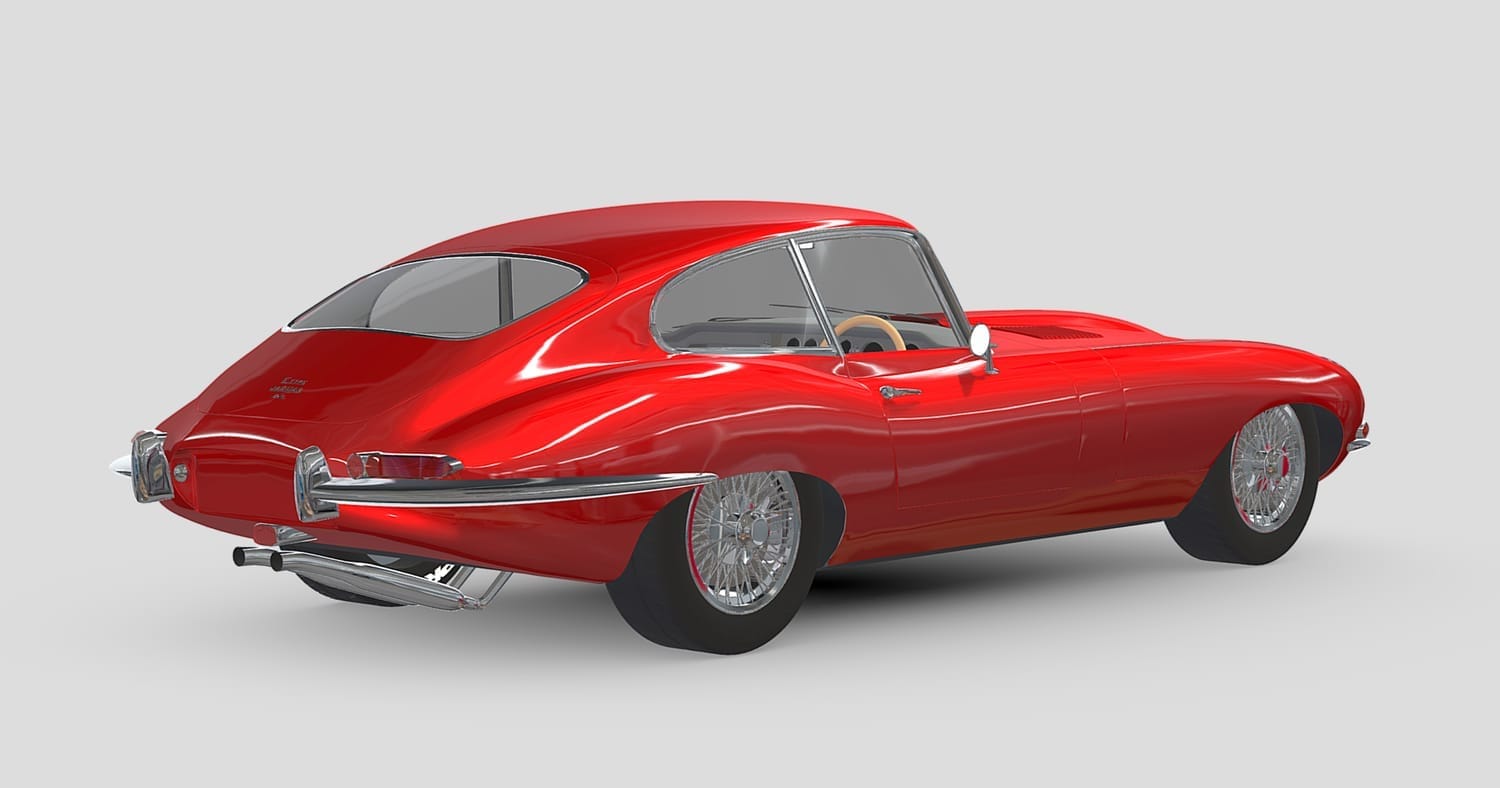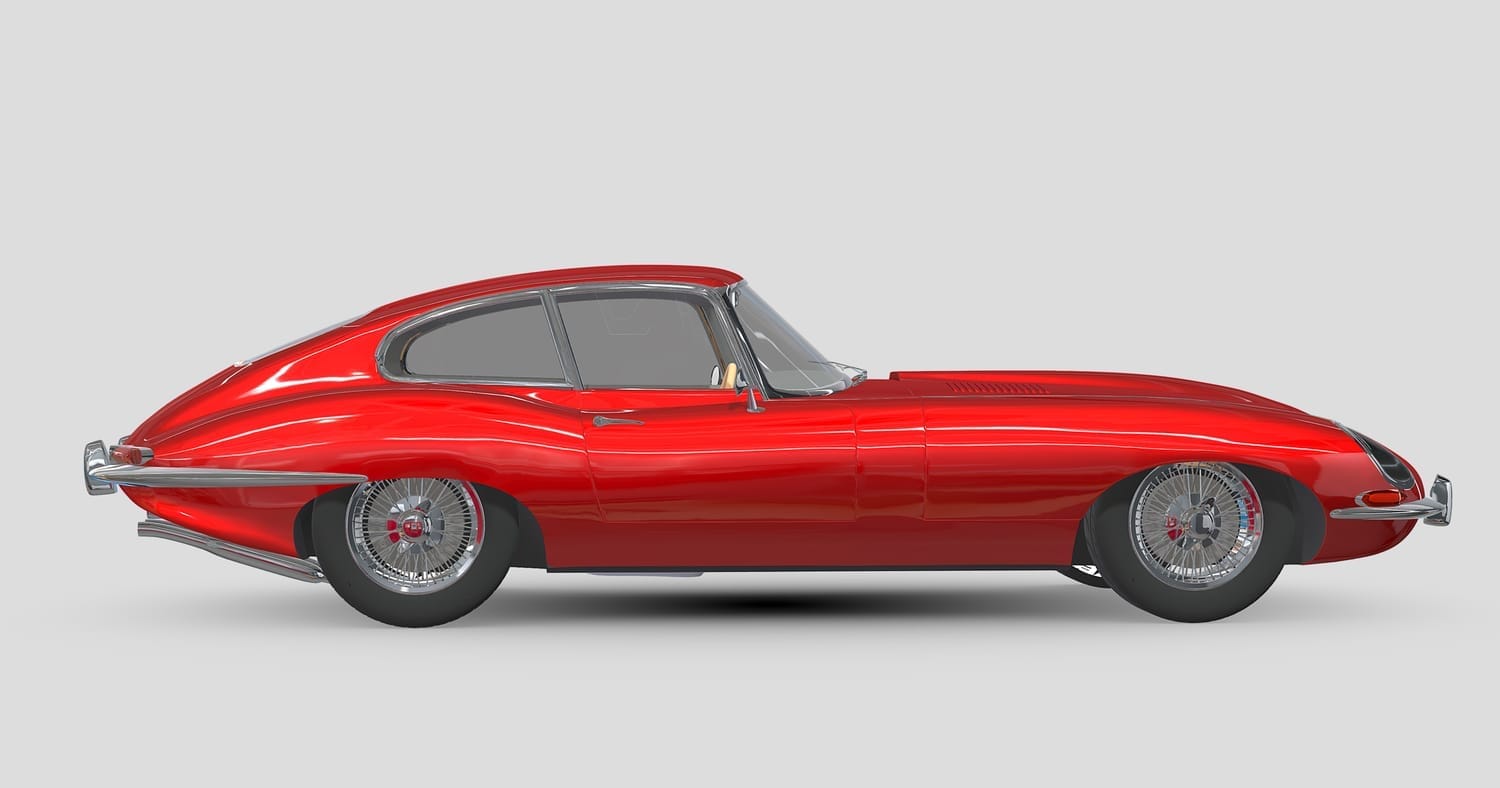Jaguar E-Type (XK-E) - Price, Specs and 360° Interactive
Jaguar E-Type (XK-E) - 360° Interactive
Jaguar E-Type (XK-E) - Key Specifications
Jaguar E-Type Series 1 4.2 Roadster Specifications
| Specification | Details |
|---|---|
| Type | Classic British Sports Car |
| Released At | 1964 (4.2L update of 1961 model) |
| Built At | Coventry, England |
| Engine | 4.2L Inline-6 (Jaguar XK engine) |
| Position | Front-Engine, Longitudinal |
| Aspiration | Natural Aspiration |
| Block Material | Cast Iron with Aluminum Head |
| Valvetrain | DOHC, 2 Valves per Cylinder |
| Fuel Feed | Triple SU HD8 Carburetors |
| Displacement | 4235 cc / 258.4 cu in |
| Power | 265 hp / 198 kW @ 5400 rpm |
| Specific Output | 62.6 hp per liter |
| Torque | 384 Nm / 283 lb-ft @ 4000 rpm |
| Top Speed | 241 km/h / 150 mph |
| 0 – 60 mph | 6.8 seconds |
| 0 – 100 km/h | 7.0 seconds |
| Body / Frame | Steel Monocoque with Tubular Front Subframe |
| Driven Wheels | RWD (Rear-Wheel Drive) |
| Wheel Type | Wire Wheels (Knock-Off) |
| Front Tires | 185 VR15 |
| Rear Tires | 185 VR15 |
| Front Brakes | Disc Brakes (Inboard) |
| Rear Brakes | Disc Brakes |
| Front Wheels | 15 x 5.5 in |
| Rear Wheels | 15 x 5.5 in |
| Front Suspension | Independent with Torsion Bars |
| Rear Suspension | Independent with Coil Springs and Radius Arms |
| Curb Weight | 1230 kg / 2712 lbs |
| Weight Distribution | Front 50% / Rear 50% (approx.) |
| Wheelbase | 2438 mm / 96 in |
| Length | 4450 mm / 175.2 in |
| Width | 1657 mm / 65.3 in |
| Height | 1225 mm / 48.2 in |
| Transmission | 4-Speed Manual (Fully Synchronized) |
| Fuel Economy (Combined) | 12.0 L/100 km / 19.6 mpg (US) |
| Fuel Capacity | 64 liters / 17 gallons |
Some Interesting Jaguar E-Type (XK-E) Facts

Famously Called “The Most Beautiful Car Ever Made” Enzo Ferrari himself once described the Jaguar E-Type as “the most beautiful car ever made,” a quote that’s still used to define the car’s timeless design and aesthetic.
Debuted with Astonishing Performance for Its Time When launched in 1961, the E-Type could reach 150 mph (241 km/h) and accelerate from 0–60 mph in under 7 seconds, making it one of the fastest production cars of its era.
Aerodynamic Design Inspired by Aircraft and Racers The E-Type’s body was influenced by aerodynamic aircraft design and Jaguar’s own D-Type Le Mans race cars, featuring a sleek, low-slung profile and covered headlamps.
Three Generations Spanning Over a Decade The E-Type was produced in three series
Available in Roadster, Coupe, and 2+2 Versions The E-Type came in three body styles: an open-top roadster, a fastback coupe, and a longer 2+2 version with small rear seats, introduced in 1966.
Initially Sold at an Incredibly Low Price Despite its performance and looks, the E-Type was shockingly affordable at launch — less than half the price of a Ferrari or Aston Martin, making it a massive value.
Used a Monocoque Construction with a Subframe The E-Type combined a steel monocoque center with a tubular front subframe, making it both lightweight and structurally advanced for its time.
Evolved from Inline-6 to V12 Power Early models used a 3.8L and later 4.2L inline-6 engine, while the Series 3 E-Type introduced a 5.3-liter V12, improving torque and long-distance cruising.
One of the Most Recognizable Classic Car Silhouettes With its long bonnet, short rear deck, and low ride height, the E-Type remains instantly recognizable, even to non-car enthusiasts.
Now a Valuable and Beloved Classic Well-preserved or fully restored E-Types are highly collectible, with Series 1 roadsters and coupes in particular commanding six-figure prices at auctions.
Jaguar E-Type (XK-E) Price

Jaguar E-Type (XK-E) Series 1 (1961–1967) – EU Price Guide (2024)
The Series 1 E-Type is the most desirable iteration of Jaguar’s icon, prized for its purity of design and driving experience. Below is a detailed breakdown of current EU market values, factors affecting pricing, and buying advice.
1. Price Ranges (EUR, Mid-2024)
By Body Style & Condition
Roadster (Open-Top) – Most Valuable
Project Car (needs full restoration, non-running): €50,000 – €90,000(Rust in floors, sills, bonnet frame; missing parts.)
Good Driver (solid, runs well, minor flaws): €90,000 – €160,000(Matching numbers, but may need cosmetic refresh.)
Concours-Quality (fully restored, pristine): €160,000 – €300,000+(Factory-correct colors, perfect chrome, documented history.)
Fixed Head Coupe (FHC) – Slightly Less Valuable
Project: €40,000 – €80,000
Driver-Quality: €80,000 – €140,000
Show-Quality: €140,000 – €250,000+
Special Series 1 Models
Flat-Floor (1961–1962): +20–30% premium (€200k–€400k+ for top examples).
3.8L (1961–1964): Often €10k–€20k more than later 4.2L cars.
"Outside Bonnet Lock" (Pre-1967): More desirable than later latches.
2. Key Factors Affecting Value
✅ Originality
Matching-Numbers Engine/Transmission: Adds 30–50% to value.
Factory Colors (Opalescent Silver, British Racing Green): Most sought-after.
Unmodified Cars > Restomods (purists pay premiums for originality).
✅ Rust & Structural Integrity
Critical Areas: Sills, floor pans, bonnet frame, bulkhead.
Cost to Restore Rusty Shell: €50k–€100k+ (labour-intensive).
✅ Provenance
Heritage Certificate (Jaguar Daimler Heritage Trust): Confirms factory specs.
Ownership History: Single-owner or celebrity-linked cars fetch more.
3. Where to Buy in the EU?
Reputable Dealers: Classic Trader, The Market by Bonhams
Auction Houses: RM Sotheby’s, Bonhams, Catawiki (for projects).
Specialists: E-Type UK, JD Classics, Eagle E-Types (high-end restorations).
4. Market Trends
📈 Appreciation:
Flat-Floor 3.8L cars up 15% yearly since 2020 (now €250k+ for top examples).
Early Roadsters (1961–1964) outperforming later 4.2L models.
⚠️ Pitfalls to Avoid:
"Matching Numbers" Frauds: Verify with Jaguar Heritage Trust.
Poor Restorations: Cheap paint/parts hurt long-term value.
5. Is It a Good Investment?
Yes, especially for: Flat-floor 3.8L Roadsters (most collectible). Low-Mileage, Unrestored Survivors (rising fast).
No, if: Buying a rusty project without budgeting €80k+ for restoration.
Pro Tip: Decode the VIN (e.g., "875005" = 1961 3.8L Roadster) and body plate to confirm authenticity.
You might also like:
Contact Details YourCar360:
Vliet 115, 8446LX, Heerenveen, The Netherlands
webmaster@yourcar360.com

